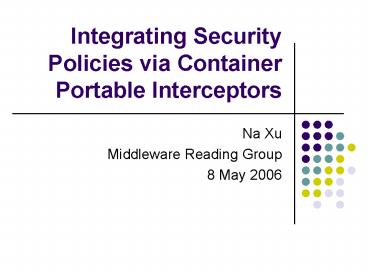Integrating Security Policies via Container Portable Interceptors - PowerPoint PPT Presentation
1 / 22
Title:
Integrating Security Policies via Container Portable Interceptors
Description:
'Integrating Security Policies via Container Portable Interceptors' ... Extended interceptor can modify the behavior of component by providing different ... – PowerPoint PPT presentation
Number of Views:27
Avg rating:3.0/5.0
Title: Integrating Security Policies via Container Portable Interceptors
1
Integrating Security Policies via Container
Portable Interceptors
- Na Xu
- Middleware Reading Group
- 8 May 2006
2
Introduction
- Discuss the paper published at RM05
- Integrating Security Policies via Container
Portable Interceptors - Security Architecture for GridKit
3
Motivation
- Develop middleware with less consideration of
security policies - Common solution directly implement security
enforcement in the application source code - Con.
- Require that the persons designing and
implementing the application components are
security specialists. - The coupling of functional and non functional
aspects hinders component reusability
4
Challenges
- Separate functional and non functional parts of
an application - Component-define business logic
- Separate security policy- enforced by runtime
infrastructure of component - Solution
- A generic framework to define and evaluate
security policies - Integrate the security framework into middleware
platform
5
System Architecture
- Targeted middleware platform
- CORBA Component Model (CCM)
- Security Framework
- OpenPMF Policy Management Framework
- Others
- Container Portable Interceptor and QoS Enabler
6
CORBA Components
- Object Model of CCM
7
Container of CORBA Component
8
CORBA Security
- CORBA security service provide
- Security administration
- Authentication
- Security context establishment
- Access control
- Security audit
- Non-repudiation
- Fundamental shortcoming
- No precise and persistent names for object
instances - No support for the technology-neutral
representation of security information
9
OpenPMF
- Properties
- A Policy Management Framework to define, manage
and enforce security policies - Technology-neutral, human-readable security
policy is stored centrally, consistently and
flexibly - Technically
- Based on MDA approach
- Security policies are expressed in terms of
attributes describing clients, initiators,
targets, operations or other context information - PDL Policy Definition Language
- Policy Repository MOF based
- PEP Policy Enforcement Points
- Architecture overview
10
(No Transcript)
11
Context Information
- Description of the context
- Functional target of call or operation invoked
- Non-functional clients credential
- Sources of context information
- Security mechanism
- Middleware platform
- Challenge
- Lack of standardization of its format and
semantic - Impossible to foresee all possibilities in policy
evaluator - Solution Transformer
12
Transformer
- Transformer an orthogonal approach for handling
context information - Provide a uniform interface to the underlying
data source - Translate security info from technology-specific
to technology-independent - Provide additional mappings identity-to-role or
clustering into application domains - Provide required comparison functionality
13
Policy Definition and Evaluation
- OpenPMF use meta-policy
- Use UML model to define meta-policy
- Use MOF standard to define the mapping of the
model to IDL interface (e.g. from meta-policy to
repository with CORBA IDL interface) - Use PDL describe policy hierarchy and rule (i.e.
meta-model) - Policy Evaluator (called Adapter at runtime)
- Deal with policy enforcement
- Integrate into the middlewares call chain
14
Container Portable Interceptor
- Portable Interceptors (PI) in CORBA
- Component Portable Interceptors (COPI)
- Adapt PI into CCM
- Provide more flexibility than CORBA PI
- Architecture
- Basic part COPI interception points is called
while ORB is dispatching a call - Extended part COPI interception points is called
while CCM container is dispatching a call - Different flow-role between two parts
- Extended interceptor can modify the behavior of
component by providing different behavior without
changing component implementation
15
Interception Points
16
Basic and Extended Interceptors
17
QoS Enabler
- Implement the COPI interface and register the
interface within the container - A QoS Enabler is a specialized component that can
be loaded into a specialized CCM component and is
able to hook in additional functionality
18
QoS Enabler in extension container
19
Conclusions (about paper)
- An integrated security middleware based on CORBA
Component model and OpenPMF policy management
framework - QoS Enabler is used to provide implementation of
the Container Potable Interceptors and provide
the hook required by security enforcement - Security policies is based on model based
software engineering process resulting in
automated and assisted policy generation
20
Security Architect for Gridkit
- Integrate security by meta-model interface
- Properties
- Open and programmable
- dynamically configurable and reconfigurable
(interaction styles and device platforms) - Configuration rules
- Initial and attach interceptors
- Load security policies
- Security services
- Confidentiality/Authentication/Integrity/Non-repud
iation
21
The future
- Abstract security policy definition
- Security policy management
- N.B. need more strong interceptor (selected,
symmetric) flexible behavior interception
22
Questions?
- Questions?
- More resources
- www.objectsecurity.com































